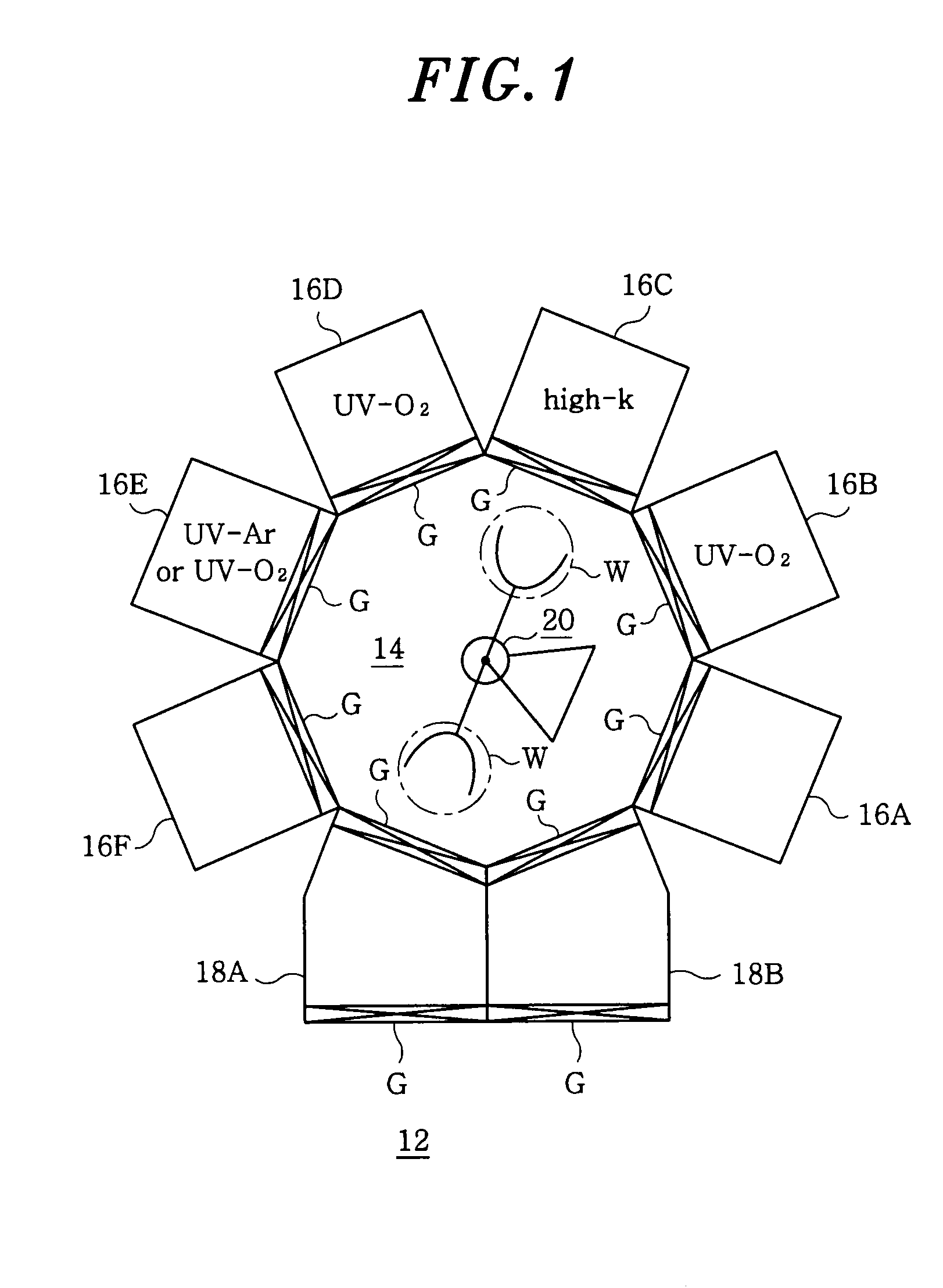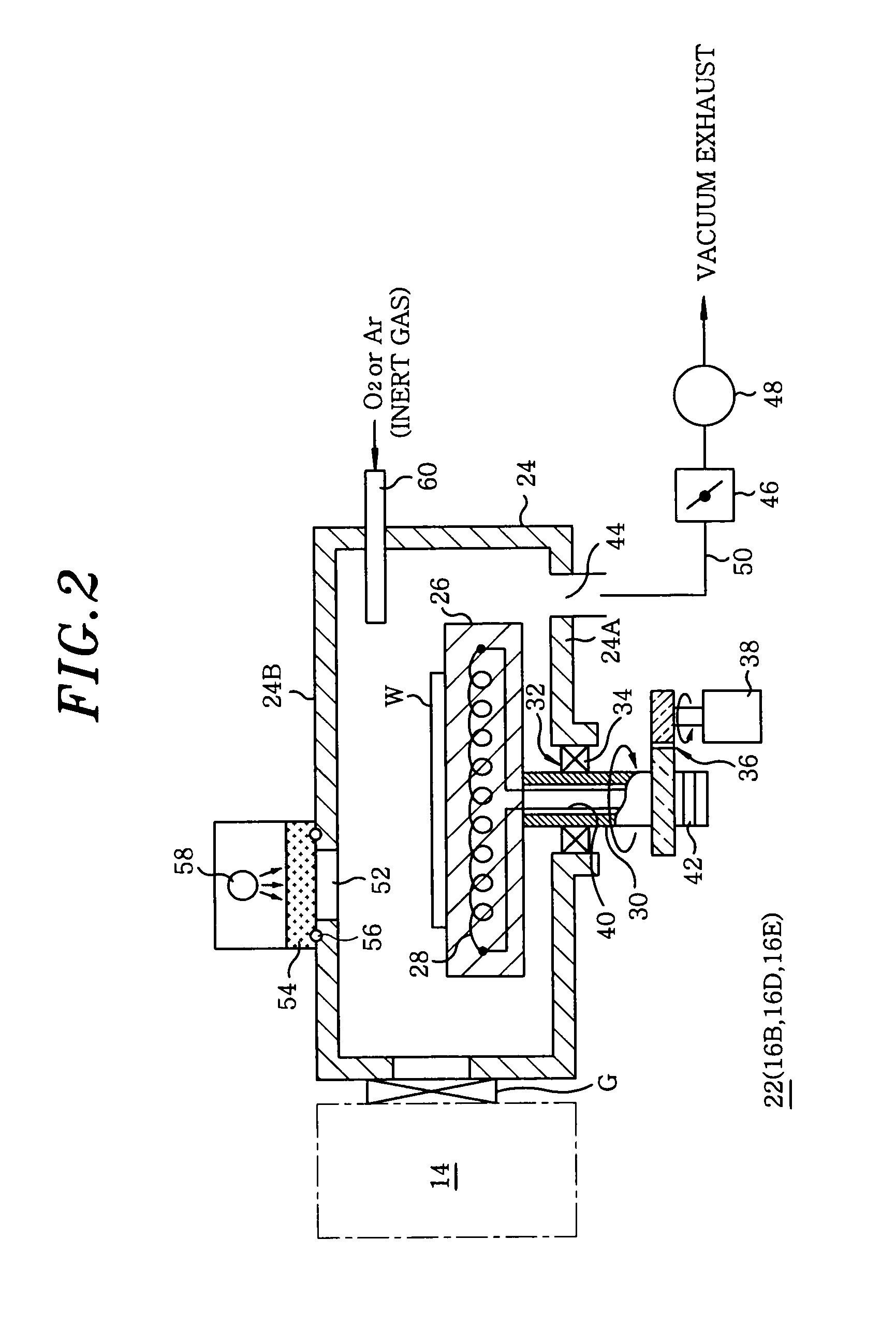Method for modifying high-k dielectric thin film and semiconductor device
a technology of dielectric thin film and semiconductor device, which is applied in the direction of semiconductor device, semiconductor/solid-state device details, electrical apparatus, etc., can solve the problems of increasing gate leakage current, unstable critical value of transistor, and carrier scattering problem in channel region, so as to prevent deficiency occurrence, improve electrical characteristics, and film density increase
- Summary
- Abstract
- Description
- Claims
- Application Information
AI Technical Summary
Benefits of technology
Problems solved by technology
Method used
Image
Examples
first embodiment
[0082]The method in accordance with the first embodiment of the present invention will be described.
[0083]FIG. 3 is a flow chart illustrating the process of the method of the first embodiment. First, a semiconductor wafer W to be processed is loaded into the common transfer chamber 14 through the load-lock chamber 18A or 18B (see FIG. 1) and then transferred to the pretreatment apparatus 16A to be pretreated (step S1). In the pretreatment process, a native oxide film on the surface of the wafer W is removed by using nitrogen radicals, oxygen radicals and NF gases as described above.
[0084]When the pretreatment process is completed, the wafer W is transferred from the pretreatment apparatus 16A to the base film forming apparatus 16B and a base film forming process is conducted (step S2). The base film forming apparatus 16B has the structure shown in FIG. 2. A base film 2 (see FIG. 15) which is a very thin SiO2 film of high surface uniformity is formed by oxidizing the surface of the w...
second embodiment
[0107]Hereinafter, a method in accordance with the second embodiment of the present invention will be described.
[0108]FIG. 5 is a flow chart illustrating a process of the method of the second embodiment. The second embodiment is different from the first embodiment described in FIG. 3 in that a reoxidation process of the step S3-1 is provided between the steps S3 and S4 in FIG. 3. In this case, modification operations are performed in both the reoxidation process of the step S3-1 and the modification process of the step S4.
[0109]To be specific, when the high-k dielectric thin film forming process of the step S3 is completed, the wafer W is transferred from the CVD processing apparatus 16C to the reoxidation apparatus 16D (see FIG. 1) and the reoxidation process of the present invention is then performed (step S3-1).
[0110]The reoxidation apparatus 16D has the structure shown in FIG. 2. UV rays from the UV lamp 58 are applied to the surface of the rotating wafer W mounted on the mounti...
third embodiment
[0118]Hereinafter, a method in accordance with the third embodiment of the present invention will be described.
[0119]FIG. 6 is a flow chart illustrating a process of the method of the third embodiment.
[0120]In the third embodiment, the order of the reoxidation process of the step S3-1 and modification process of the step S4 of the second embodiment shown in FIG. 5 are reversed and the reoxidation process is indicated here as the step S4-1.
[0121]The third embodiment can provide the same effects as those in the first embodiment as described above. Further, in the third embodiment, the film quality is improved by compensating for the oxygen deficiency of the high-k dielectric thin film 4 and the film density is increased by reducing the carbon concentration and sintering, as described in the second embodiment.
[0122]If UV rays are applied to the high-k dielectric thin film 4 in an Ar atmosphere in the modification process of the step S4, the film surface may be damaged by UV rays with h...
PUM
| Property | Measurement | Unit |
|---|---|---|
| wavelength | aaaaa | aaaaa |
| temperature | aaaaa | aaaaa |
| thickness | aaaaa | aaaaa |
Abstract
Description
Claims
Application Information
 Login to View More
Login to View More - R&D
- Intellectual Property
- Life Sciences
- Materials
- Tech Scout
- Unparalleled Data Quality
- Higher Quality Content
- 60% Fewer Hallucinations
Browse by: Latest US Patents, China's latest patents, Technical Efficacy Thesaurus, Application Domain, Technology Topic, Popular Technical Reports.
© 2025 PatSnap. All rights reserved.Legal|Privacy policy|Modern Slavery Act Transparency Statement|Sitemap|About US| Contact US: help@patsnap.com



